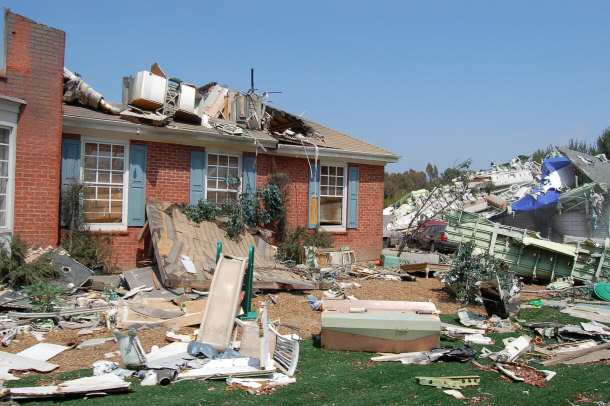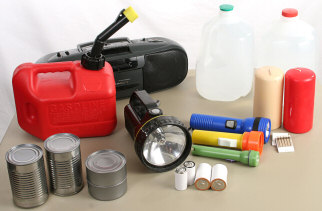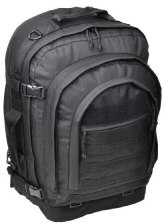Preparing for a Disaster Checklist

Natural disasters seem to be occurring more frequently than in past years.
Hurricanes, tornadoes, floods and snowstorms can all have a devastating effect
on the areas they impact causing extended power loss, the inability to access
clean water, and shortages of food. Although the government tries to respond
quickly to these events, they cannot respond immediately or with sufficient
supplies as evidenced by recent events in New York and New Orleans. Therefore,
you must be prepared to survive these events should they strike your hometown.
Now, I know what youíre thinking -ďThis sounds a little crazy. Iíve seen those
preparation shows and those people are nuts!Ē Granted, most of those people are
preparing in massive ways for large scale events, but they are far from crazy. In fact, the Federal Emergency Management Agency (FEMA) has run several
preparedness commercials on TV, strongly recommends preparing at least a 3 day
survival kit and has setup a website called
www.ready.gov to educate the public
on the importance of disaster preparedness. You donít have to stockpile years of
food and water like the disaster preparers on TV, but there are several key
things you should have ready.
What You Need in Your Disaster Survival Kit
-
 Water -
You need 1 gallon per person for a minimum of 3 days. This water
is used for drinking and hygiene purposes. Water -
You need 1 gallon per person for a minimum of 3 days. This water
is used for drinking and hygiene purposes.
- Non-perishable food - Canned goods and military MREs (meals ready to eat)
are excellent for this purpose. You need enough food for everyone in your
family for 3 days. Pay attention to the calorie content and make sure your
meals provide at least 1200 calories per person, per day.
- Can opener - (the manual kind). If thereís no power you need to be able to
access your canned food easily.
- Radio - battery or crank powered. When the power is out, a radio may be
your only source of emergency information. Make sure you have extra
batteries.
- Flashlights and extra batteries
- Dust masks - to keep contaminate and debris filled air from being
inhaled.
- Whistle - this can be used to signal for help and is much easier on the
body than screaming.
- Wet wipes, toilet paper, paper towels, garbage bags - These are used for
hygiene and sanitation purposes. If your toilet isnít functioning you need a
way to dispose of your waste safely.
- Temporary shelter - this can be plastic sheeting and duct tape or a
collapsible tent. If your home is destroyed or unsafe to remain in, you will
need an alternative means of shelter.
- Maps - local maps of your area.
- Compass
- First-aid kit
- Identification - driverís licenses, birth certificates, passports, etc.
- Cash - at least $100.00. You may not be able to access your bank account
- Alternate cooking source (camping stove, grill, etc.)
- Alternate heat source - a generator is a good investment and can heat
your home and power essentials if disaster strikes during the cold winter
months.
The above is a check list of basic supplies needed in the event of an emergency. However, it may be difficult if not impossible, for one person to carry all of
these items and personal items are not included in the main kit. I have found
the easiest way to distribute the supplies is to make what is known as a Bug Out
Bag, or BOB, for each family member. We use backpacks for our Bug Out Bags.
What is a Bug Out Bag?
 Also know as a "Get Out of Dodge Bag", a Bug Out Bag Also know as a "Get Out of Dodge Bag", a Bug Out Bag is to be designed for
just that; to get out of town or out of a desperate situation as quickly as
possible with the important items you will need to survive for at least three days, if not longer.
Under distress it would be hard to remember everything to put in the bag, so you
should prepare these bags and have them ready in case of emergency. Even
with a clear mind, coming up with a complete list of "essentials" is hard to do
without giving it alot of thought. Below I've listed the items you should
start your bag with.
is to be designed for
just that; to get out of town or out of a desperate situation as quickly as
possible with the important items you will need to survive for at least three days, if not longer.
Under distress it would be hard to remember everything to put in the bag, so you
should prepare these bags and have them ready in case of emergency. Even
with a clear mind, coming up with a complete list of "essentials" is hard to do
without giving it alot of thought. Below I've listed the items you should
start your bag with.
What Goes in Your Bug Out Bag
Remember: these must be made for
each family member.
- 2 complete changes of clothing. Make sure these are appropriate to the
time of year. We change our clothing out in the winter and summer. Pack
jackets and gloves as needed.
- Extra pair of shoes
- Flashlight
- Whistle
- Personal hygiene items - toothbrush and toothpaste, soap, small towel, hand
sanitizer, deodorant etc.
- Matches - as age appropriate.
- Pocket knife - as age appropriate.
- Canteen or water bottle.
- Food - a 3 day supply. To eliminate weight, use freeze dried packages of
food or MREs removed from their packaging.
- Snacks - protein bars etc.
- Small Blanket
- Personal medications
- Water - at least 3 liters
- Water purification tablets - these are necessary if you must leave your
home and cannot take your water supply with you.
-
 Dust masks Dust masks
- Mess kit - for eating and preparing food
- Sanitation items
- Money
- Shelter
- First-aid kit
- Radio
- Candles
NOTE: Shelter, money, first-aid
kit, radio and age inappropriate items should go in or on an adultís bag.
This list could go on and on but these are the essentials you will need
should you have to leave your home. Based on your familyís requirements, you can
add to this list as needed. In order to save room in your Bug Out Bag, buy trial
sizes of hygiene items, use a larger pack with exterior pockets, and roll your
clothes instead of folding them. Your Bug Out Bags should always remain packed
and ready for use in an easily accessible area of your home.
Conclusion
A natural disaster may never strike your home. However, if one does, and you are
caught unprepared your family may suffer until help arrives. Planning and
preparing for a natural disaster will provide your family with the essentials
needed for survival and give your family a sense of security in a time of
uncertainty.

Nature
Top Lists:
15 Fascinating Facts about the Amazon Rainforest
15 Remarkable Facts About Bacteria
15 Remarkable Facts About Jellyfish
15 Little Known Facts About Elephants
15 Fascinating Facts about Earthquakes
15 Odd And Interesting Facts about Monkeys
Top 15 Myths about Snakes
Top 15 Myths about Horses
Top 15 Creepy Deep Sea Creatures
15 Unexpected Animals That Can Kill You Quickly
Top 15 Spider Myths
15 Beautiful Animals that are Now Extinct
Top 15 Most Amazing Snakes Around the World
15 Fascinating Facts about Snow
Top 15 of the World's Rarest Flowers
10 Most Emotional Animals
15 of the Most Venomous Creatures to Roam the Earth
15 Unusual Animal Defense Mechanisms
15 Unusual and Less Known Uses of Rocks
15 Unique Forest Creatures Less Known To Man
15 Interesting Facts About Time
15 Unknown Parasites You Never Knew Existed
15 Weird Trees Around The World
15 Wild Animals Deadly to Humans
15 Exotic Insects That Are Harmful & Deadly
15 Ridiculous Uses for Gold
Informational:
Preparing for a Disaster
Proof That We Are What We Are!
What is the Meaning of Life?
The Trend and Challenges Facing the Urban World
Creation Narratives and the Evolution Creationist Debate |